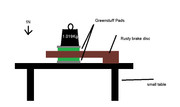Quote:
Quote:
I think this is exactly where people are getting confused. The input into the hydraulic system is still the same - therefore the sum of the outputs must be the same - unless you're affecting pedal travel distance as well.
Don't be daft. The force from the hydraulic pressure on two pistons is twice the force on one piston. Two have twice the area of one, and pressure is force divided by area. So if you have the same pressure and twice the area, you have twice the force. But this only applies to the two pot fixed caliper.
But you'd need to push the pedal harder for that to be true. Are you suggesting that if I got 1000 hydraulic rams I could lift a house, but it'd feel no different than one ram lifting a feather? That's just not true. If that was the case then there would only be one size of hydraulic pump - tiny! You need larger input volume for more output volume - and in doing so you're requiring a larger force to act on it.
The force IS the same because the pressure is the same. BUT in order to actually move the piston/ram and do any WORK (FORCE x DISTANCE) you would have to move the MASTER Piston or pump further, that is the difference. So in your example of 1 ram lifting a feather versus 1000 rams lifting a house, you would have to move the MASTER cylinder/piston 1000 times further using the same force to lift the house the same distance as 1 ram lifting your feather. Not Press Harder, but move further.
